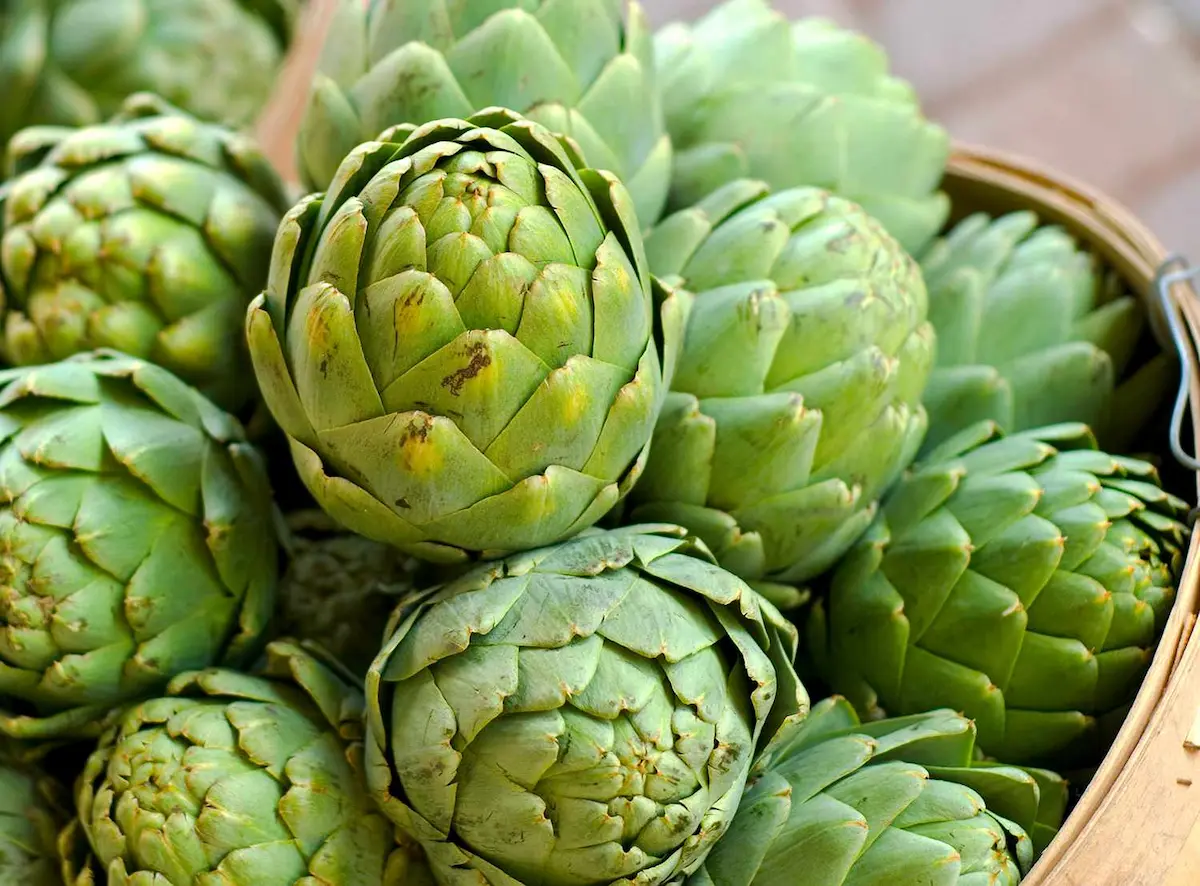If you’ve seen these unusual-looking vegetables in the produce section, you may have wondered – what does an artichoke taste like? With their almost prehistoric appearance, artichokes aren’t the most inviting or familiar ingredients. However, their unique flavour and texture make them worth trying if you’re looking to expand your culinary horizons.
Artichokes have a rich, complex taste, unlike any other vegetable. Their flavour is difficult to compare but has been described as nutty, earthy, sweet and almost meaty.
They combine tastes and textures in a way that manages to be soft and firm, floral and vegetal, all at the same time.
Some Key Tastes and Textures
When describing what artichokes taste like, the same keywords tend to come up over and over again. Here’s a breakdown of some of the characteristic flavours these unusual veggies impart:
Nutty, earthy richness – This is the predominant flavour in artichokes. Some compare it to the heart of palm or roasted chestnuts. The meaty heart and inner leaves have a hearty, wholesome taste.
Sweet yet bright notes – While rich, there is also a brightness to artichokes that balances out the earthiness. This sweetness is especially apparent in younger, smaller veggies or the innermost leaves.
Firm texture with softness – Artichokes have a distinct soft crunch to them, especially the meaty heart. The inner leaves pull off the heart easily with a velvety texture.
Herbal, grassy qualities – There is a distinctly vegetal taste to artichokes as well, with fresh herbal notes reminiscent of the thistle plant family they belong to.
Slight bitter finish – Young artichokes tend to be sweeter and less bitter. As they age and grow larger, bitterness becomes more pronounced, especially in the outer leaves.
As you can see, artichokes offer an amalgamation of opposing flavours. It’s this complexity that makes them so distinct and appealing for many people willing to give them a taste.
How Do You Cook and Eat Artichokes?
Part of discovering what artichokes taste like depends on how you choose to prepare them. Here are some of the most common ways they are served:
Steamed or boiled – This simple preparation is popular, as it softens the meaty hearts and inner leaves, accentuating their sweet herbal flavours.
Roasted – Roasting caramelizes artichokes, doubling down on their rich nuttiness. Oil and seasonings give another layer of flavour.
Grilled – Like roasting, grilling heightens the veggies’ sweetness while adding irresistible charred bits. This preparation best showcases artichokes’ unique taste.
Raw – Shaved raw artichoke hearts work nicely in salads, combining crunch with soft herbal notes. Their bitterness pairs well with tangy lemon and bold dressings.
Fried – Fried artichoke hearts are an Italian classic. Crispy hot oil contrasts with the cool, sweet meatiness of the interior.
In pasta/pizza – Artichokes adapt well to all kinds of Italian cooking. Their subtle flavours perfectly match the tomatoes, olives, cheese and herbs commonly paired with them.
Eating artichokes also utilizes unique table manners. The intricate leaves are plucked off one by one, dipped in sauce or dressing, and dragged through the teeth to remove the soft, sweet flesh with a firm crunch. Eventually, you reach the coveted heart, which is fully edible.
What Do Artichokes Taste Like? Common Descriptors
Some of the words that pop up most frequently when food writers attempt to translate artichokes’ essence into language include:
- Earthy
- Hearty
- Sweet
- Bright
- Grassy
- Herbal
- Nutty
- Woody
- Mellow
- Savoury
- Mushroomy
- Mild
- Minerally
- Buttery
- Vegetal
- Fragrant
- Creamy
- Briny
- Rich
- Smoky
- Floral
- Honeyed
- Velvety
- Tempered
As you can see, descriptions span quite a range as people grasp to define their enigmatic taste. Artichokes straddle the line between floral and earthy, salty and sweet, mellow and bold. It’s this hard-to-pin-down quality that makes them such an intriguing ingredient.
Taste Variations Between Artichoke Types/Cultivars
Over 120 different varieties of artichokes exist, ranging dramatically in size, appearance and taste.
In general, smaller, younger artichokes tend to have softer leaves, larger hearts and a sweeter flavour. Their lack of bitterness makes them ideal for eating raw or lightly cooked.
Types like Violetta, Emerald and Parisienne are smaller “baby” artichokes often eaten whole. Greensmith, Imperial Star and Desert Globe have firmer, meatier textures but can also be quite sweet.
Larger globe artichokes can develop very big secondary shoots called stems, almost akin to broccoli. These stems soften and sweeten when cooked, contrasting with the more bitter leaves.
Big, fully mature artichokes like Green Globe or Giant Purple can have pronounced bitter and grassy flavours, especially in their outer leaves. However, their huge hearts are still treasured for recipes where artichokes are a main component.
No matter what the variety, the interior at the heart of the artichoke always remains the sweetest part.
What Does an Artichoke Heart Taste Like?
Since they’re the ultimate artichoke prize, what exactly do artichoke hearts taste like? Most compare them to other heart-shaped vegetables like baby squash or hearts of palm.
Artichoke hearts offer a concentrated version of the vegetable’s characteristic nutty flavour, but they are brighter, sweeter and more floral. Without any bitter notes or tough outer leaves, the velvety interior has clear tastes of roasted sweet potato combined with fresh parsley or basil.
Texture-wise, artichoke hearts have a soft but substantial crunch. When cooked, they turn extremely tender, almost buttery or creamy. Their rich meatiness lets them hold up well to all types of cooking methods and combinations. But most would agree artichoke hearts are best enjoyed very simply – steamed and dipped in lemon butter, pure heaven!
What do Canned or Jarred Artichoke Hearts Taste Like?
For convenience, many opt for canned or jarred artichoke heart quarters versus fresh. But how do they compare taste and texture?
While not quite as sweet or grassy-tasting as fresh, processed artichoke hearts still capture much of the native nuttiness and unique floral quality intact. However, they do tend to take on the flavours of whatever oil or liquid they’re stored in. Brands packed in saltwater or brine can have a duller, more bitter and pickled flavour. Oil-packed hearts tend to retain more sweetness.
No matter what, all preserved artichoke hearts possess a much softer, almost stringy texture compared to the slight crunch of fresh ones. Their cell walls break down from the cooking/canning process, creating a baby food-like consistency. They don’t quite replicate the rich meatiness and buttery inside texture adored by true artichoke lovers. But their convenience still makes them a pantry staple for artichoke aficionados.
Health Benefits and Nutrition
Beyond its distinctive taste, the artichoke is also cherished as a superfood, packed with many healthy nutrients and bioactive compounds:
High in antioxidants – Artichokes have more antioxidants than almost any other vegetable, lowering inflammation and preventing disease.
Rich in fibre – Fiber improves digestion, gut health and heart health.
Packed with vitamins/minerals – Provides vitamin C, vitamin K, B vitamins, magnesium, and potassium.
May lower cholesterol – Contains cynarin, which helps get rid of excess cholesterol.
Bolster’s liver health – The antioxidant cynarin also protects the liver from toxins.
Aids digestion – Bile-stimulating properties benefit digestion and thus the whole body.
With all these evidence-backed benefits, their unique flavour is just the icing on the cake motivating artichoke fans to go for more!
What About All the Other Parts – Stems, Leaves etc?
While hearts and bottoms are considered the “prime cuts”, even the stems, leaves and thorny exterior are edible on artichokes. However, flavour varies greatly between these different parts.
In general, outer leaves and spiky tips are the toughest with the highest concentration of bitter, grassy compounds. The most tender leaves are at the centre, with a sweet, nutty taste matching the hearts.
Lower stem portions can be tasty when peeled and cooked to melting tenderness. But stem tips and upper parts tend to be tough, woody and stringy.
Flatter exterior leaves like those covering the bottom plus immature flower buds or shoots offer another nice edible portion. These parts taste similar to the heart – sweet and nutty.
So while the outer leaves and upper stems don’t have much flavour merit on their own, nothing on an artichoke needs to go to waste.
Pairings and Condiments That Go Well With Artichokes
One of the joys of cooking with artichokes is discovering all the delicious flavours and textures they pair beautifully with. Their versatility allows them to feature in all kinds of dishes spanning pesto to paella.
Here are some classic ingredient pairings and condiments that bring out artichokes’ tastiness:
Butter/olive oil – Rich, velvety melted butter or fruity extra virgin olive oil does wonders to enhance artichokes’ sweet nuttiness.
Cheeses – Saltiness and creaminess perfectly offset bitter notes. Parmesan, feta, mozzarella, goat cheese and blue cheese work especially well.
Garlic – Roasted garlic mellows to a sweet paste that melds with artichokes seamlessly.
Lemon – Bright acid cuts the richness and balances flavours. Lemon zest also boosts the floral taste even further.
Vinegar – Similarly, a splash of vinegar adds bite. Sherry, balsamic and white wine vinegar shine.
Herbs – Basil, tarragon, thyme and parsley all echo artichokes’ herbal qualities.
Hazelnuts/walnuts – These nuts have similar nutty, slightly bitter flavours that make them natural complements.
Seafood – Briny, savoury tastes pair beautifully with artichokes’ minerality. Scallops, shrimp, crab and clams are divine matches.
Pasta/breadcrumbs – Toasted crumbs give a fab crispy crust and textural contrast to otherwise soft artichokes.
As you can see, just about anything that brings either rich creaminess, bright acid or lots of herbs harmonizes taste-wise. Lean meats like chicken or turkey also benefit from artichokes’ juiciness and fat-mimicking qualities. Getting creative mixing and matching complementary flavours lets you discover all kinds of tasty artichoke combinations!
Tips for Introducing Artichokes Into Your Diet
If you’re keen to try these unusual vegetables but don’t know where to start, follow this handy beginner’s guide:
- Begin with baby artichokes, as they are the sweetest and mildest
- Focus first on just the hearts, trimming the leaves and fuzzy chokes
- Opt for oil-packed canned/jarred hearts to remove all bitterness
- Steam or roast simply dressed with oil, salt and garlic
- Serve warm with either melted butter, lemon juice or quality olive oil for dipping
- Move onto whole steamed artichokes once comfortable with the taste
- Pull leaves slowly, one by one, dipping the fleshy ends in a flavorful sauce
- Save any leftover parts to add to homemade stock
While an acquired taste for some, artichokes are truly one of nature’s culinary marvels. These thistle buds flaunt an incredible range and complexity hard to find in vegetables. With so many tasty preparations possible, artichokes make for an excellent (and healthy) kitchen adventure. Trust us, take a bite and you’ll be won over by their charm quicker than you can say cardio!

